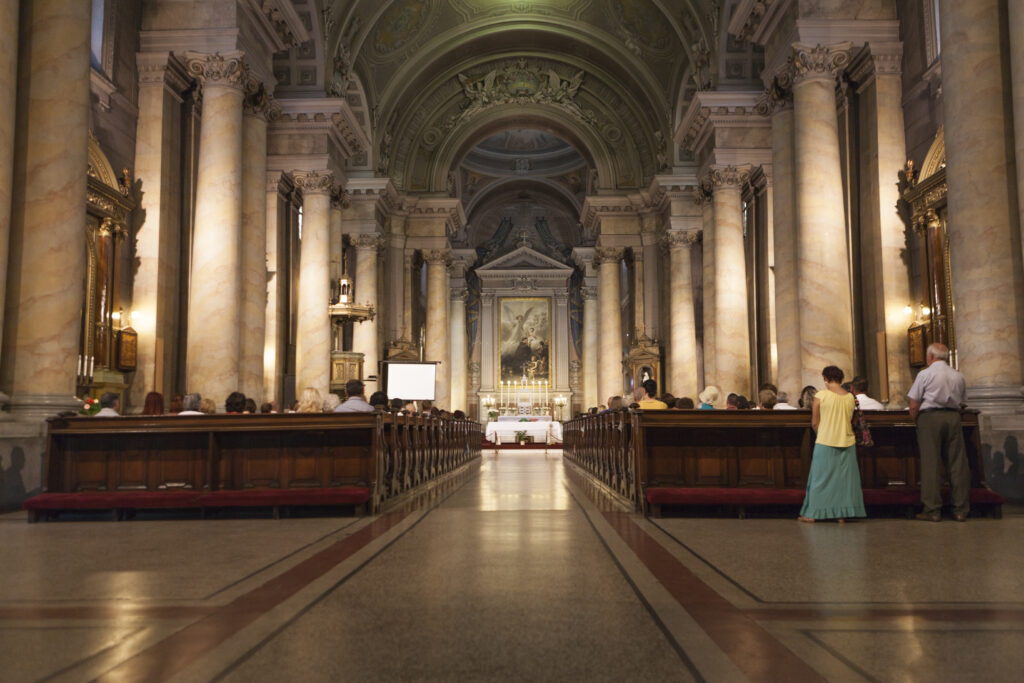Can first time visitors figure out our customs and liturgy?
 By Tim Sitterley, Regional Director US West
By Tim Sitterley, Regional Director US West
I will never forget my first visit to a Catholic mass. Having grown up in WCG/GCI, I had no idea what to expect. What was up with people dipping their fingers in a water basin upon entering? The first time there was a call and response in the liturgy, and everyone responded loudly with the Kyrie Eleison (Lord have mercy), I almost jumped out of my skin. But after a couple of responses, I was ready, only to find out as I shouted “Kyrie Eleison,” that the response had now changed to Christe Eleison (Christ have mercy). People would kneel, and as I was kneeling, they stood back up. I was smart enough to stay in my seat during the Eucharist, and I slipped quietly out the back door while the ushers were thrusting an offering basket on a pole in front of each parishioner. I have no idea what happened after that.
Most of our worship services are not nearly as intricate and potentially confusing as a traditional Catholic mass. But that doesn’t mean that parts of our liturgy can’t be just as frustrating and scary to a first-time visitor, particularly if they don’t have much of a church background. Even our vocabulary can be intimidating. (“Washed in the blood” sounds like something from the TV show “Criminal Minds.”)

As one who visits congregations as part of my job, I’ve seen and experienced many things that would have me heading to the back door if I were new to the faith and looking for a church. Here are just a few examples … and I promise to not mention congregations by name.
I arrived at one congregation 20 minutes early and could not find a single person in the sanctuary. It was evident I was in the right place, but where were the people? It turns out that on certain days of the month they gather in another part of the rented church campus for breakfast. I wandered around until I heard voices, but a visitor would have been back in their car and on their way long before the members made their pilgrimage back to the sanctuary.
Times of praise and prayer can also be times of confusion and stress to visitors. In one congregation we spent 43 minutes talking about everyone’s problems (I’m not exaggerating). Imagine how that comes across to a first-time visitor when more time is spent sharing our problems than focusing on the solution – Jesus.
One congregation has everyone stand up for the reading of scripture. Do you sit or stand during the offering? (Is there consideration for those who are in pain when they stand?) Is the benediction the final word of the service, or is there something afterward? Is one of those people speaking to us the pastor? These are all relatively small issues for a visitor, but they do add up quickly. The last thing a visitor wants is to be spotlighted by their own actions (and they certainly shouldn’t be spotlighted from the stage).
And the biggest and most confusing piece of liturgy a first-time visitor will encounter in our congregational worship service is communion. I’ve seen the invitation to the Lord’s table conducted in so many ways that, even though this is the world I work in, I’m sometimes confused as to what to expect. Are the elements passed? Do I take them immediately, or do I wait for further instructions? Do we get up and go somewhere to get the elements? Who is invited to take the elements? And don’t get me started on proper traditions for intinction (dipping the bread into the communal cup), if that is your style.
I attended a service where the communion elements are available each week on a table at the side of the sanctuary, but the congregation only celebrates communion collectively once a month. The other weeks members are free to get up at any time during the service to privately take the elements if they so choose. Most people get up during the last song. Unfortunately for a first-time couple, when several in their row got up (with no announcement or instructions from the stage) and went to the table, the couple assumed this is what everyone did. They retrieved the bread and wine and waited for instructions for when to partake – instructions that never came, leaving them to quickly take the elements after the benediction while people around them introduced themselves.
At the end of the day, there is a simple solution to avoid first-time confusion, embarrassment, and visitors slipping quietly out the door. Three easy steps: communication, communication, and communication. First, always plan for visitors, and explain to the members that we are always planning for visitors.
Are the elements of your weekly worship liturgy outlined in your handout bulletin?
- Speaker and his/her role. (Elder, youth pastor, assistant pastor, etc.)
- Order of services.
- Written instructions for the offering and communion.
- Location of restrooms and fellowship hall.
If you really want to get a feel for how visitor-friendly your worship customs and liturgy are, you can always do what a pastor friend of mine did. He asked a neighbor, who didn’t do church at all, if he and his wife would attend one of their services and give him some feedback. He was amazed (and somewhat saddened) by the observations given to him. Some radical changes were made in the weekly service, from training for the greeters to a list of “reminders” of things to clarify that were laminated and attached to the lectern.
Shortly before COVID I was invited to attend a congregation outside my region, and the experience opened my eyes to the possibilities. Few people there beyond the pastor knew me, so for all practical purposes I was a first-time visitor. I was greeted in the parking lot by a couple of teens. They introduced me by name to a greeter at the door who walked with me into the sanctuary. I was introduced by name to the ladies at the coffee table and loaded up with a cup of fresh coffee and a doughnut. After a quick tour of the building, I was handed a bulletin that answered almost any question a visitor could ask. By the time the pastor saw me and made it clear I was not a potential new member, I already felt totally at home in that service.
A healthy church is intentional in communicating to visitors. The sooner we can impart the “what,” the sooner our visitors can focus on the “why” and the “who.” May our customs and liturgy never get in the way of the “who.”



At its core, the solution is quite simple. It’s all about showing “intentional love”, isn’t it ? The more, and the better, we focus on people’s needs, the more we will be a home, and not just a house, to visitors and seekers.
Great article, Tim! Way to go to the highlighted church who knew the importance of communication. Communication. Communication. This reminds me of what I always pass on at a bridal shower or wedding reception when asked for successful marriage tidbits…. “Communicate. Communicate. Communicate”.
As part of a GCI Church Plant, thank you for passing on the good and the not so good of what you have experienced.
Stacey Meade